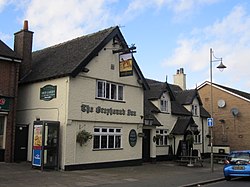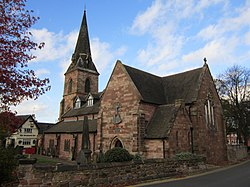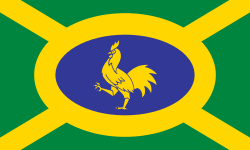Penkhull: Difference between revisions
Created page with "{{Infobox town |name=Penkhull |county=Stafford |picture=Greyhound Inn, Penkhull.jpg |picture caption=Greyhound Inn, Penkhull |os grid ref=SJ868448 |latitude=53.0007 |longitude..." |
No edit summary |
||
| Line 15: | Line 15: | ||
|constituency=Stoke-on-Trent Central | |constituency=Stoke-on-Trent Central | ||
}} | }} | ||
'''Penkhull''' is a village in [[the Potteries]] of [[Staffordshire]]: it is a township of [[Stoke-upon-Trent]], one of 'the Six Towns' of the | '''Penkhull''' is a village in [[the Potteries]] of [[Staffordshire]]: it is a township of [[Stoke-upon-Trent]], one of 'the Six Towns' of the Potteries which together form the city of [[Stoke-on-Trent]]. | ||
Penkhull is one of 20 or so conservation areas in Stoke-on-Trent, and includes Grade II listed buildings such as the church and "The Greyhound Inn" public house and restaurant. <ref> [http://www.thepotteries.org/tour/014.htm Neville Malkin's Grand Tour of the Potteries]</ref> | Penkhull is one of 20 or so conservation areas in Stoke-on-Trent, and includes Grade-II-listed buildings such as the church and "The Greyhound Inn" public house and restaurant. <ref> [http://www.thepotteries.org/tour/014.htm Neville Malkin's Grand Tour of the Potteries]</ref> | ||
The name of the village is of uncertain origin but the [[Victoria County History]] suggests that it is from the British language ''pencet'' ('end or head of the wood', like the modern Welsh ''pen coed'') and the Old English ''hyll'' ('hill').<ref>{{VCH|8}}</ref> John Ward<ref>Ward, John: 'The Borough of Stoke-upon-Trent' (1843)</ref> suggests the British ''pen'' ('head') and ''kyl'' ('kiln'). The idea of a 'head' or 'end' is topographically apt, since the village is sited on the elevated end of a long strip of valley-side woodland which begins at the ancient Bradwell Wood five miles to the north. | The name of the village is of uncertain origin but the [[Victoria County History]] suggests that it is from the British language ''pencet'' ('end or head of the wood', like the modern Welsh ''pen coed'') and the Old English ''hyll'' ('hill').<ref>{{VCH|8}}</ref> John Ward<ref>Ward, John: 'The Borough of Stoke-upon-Trent' (1843)</ref> suggests the British ''pen'' ('head') and ''kyl'' ('kiln'). The idea of a 'head' or 'end' is topographically apt, since the village is sited on the elevated end of a long strip of valley-side woodland which begins at the ancient Bradwell Wood five miles to the north. | ||
| Line 29: | Line 29: | ||
==The Church== | ==The Church== | ||
[[File:St Thomas Church, Penkhull (2).jpg|right|thumb| | [[File:St Thomas Church, Penkhull (2).jpg|right|thumb|250px|St Thomas's Church]] | ||
The parish church in Penkhull is the Church of St Thomas.<ref>[https://www.achurchnearyou.com/penkhull-st-thomas/ A Church Near You – St Thomas, Penkhull]</ref> | The parish church in Penkhull is the Church of St Thomas.<ref>[https://www.achurchnearyou.com/penkhull-st-thomas/ A Church Near You – St Thomas, Penkhull]</ref> | ||
The church | The church was built when the parish was created out of the ancient parish of Stoke in 1844 <ref>Talbot, Richard: 'The Church and Ancient Parish of Stoke-upon-Trent' (Webberley Ltd, Hanley, 1969) page 57</ref><ref>[http://www.thepotteries.org/tour/013.htm Neville Malkin's Grand Tour of the Potteries]</ref> The church is by Scott and Moffatt. The Revd Thomas Webb Minton, the son of Thomas Minton and Rector of Darlington, gave the sum of £2,000 to be invested from which the interest provided an income for the Vicar. The aisles were added in 1892 by Edward Prioleau Warren.<ref>{{Pevsner|p=263}}</ref> | ||
==Music and Performing Arts== | ==Music and Performing Arts== | ||
| Line 44: | Line 44: | ||
==Village flag== | ==Village flag== | ||
[[File:Penkhull village flag.svg|right|thumb| | [[File:Penkhull village flag.svg|right|thumb|250px|The Village Flag]] | ||
A village flag was designed for Penkhull in 2018. It shows a green field, for the village green, a rare commodity amongst the villages of the Potteries, and a saltire for the crossroads at the heart of the village. On top of this is a roundel in the shape of Spode tableware, to recall the effective creation of the village by Josiah Spode, who was of the village himself, and on top of it a cock, for the prominent church weathervane.<ref>[http://www.flaginstitute.org/wp/flags/penkhull-staffordshire/ The UK Flag Register: Penkhull]</ref> | A village flag was designed for Penkhull in 2018. It shows a green field, for the village green, a rare commodity amongst the villages of the Potteries, and a saltire for the crossroads at the heart of the village. On top of this is a roundel in the shape of Spode tableware, to recall the effective creation of the village by Josiah Spode, who was of the village himself, and on top of it a cock, for the prominent church weathervane.<ref>[http://www.flaginstitute.org/wp/flags/penkhull-staffordshire/ The UK Flag Register: Penkhull]</ref> | ||
Latest revision as of 08:13, 22 September 2018
| Penkhull | |
| Staffordshire | |
|---|---|
 Greyhound Inn, Penkhull | |
| Location | |
| Grid reference: | SJ868448 |
| Location: | 53°0’3"N, 2°11’48"W |
| Data | |
| Post town: | Stoke-on-Trent |
| Postcode: | ST4 |
| Dialling code: | 01782 |
| Local Government | |
| Council: | Stoke-on-Trent |
| Parliamentary constituency: |
Stoke-on-Trent Central |
Penkhull is a village in the Potteries of Staffordshire: it is a township of Stoke-upon-Trent, one of 'the Six Towns' of the Potteries which together form the city of Stoke-on-Trent.
Penkhull is one of 20 or so conservation areas in Stoke-on-Trent, and includes Grade-II-listed buildings such as the church and "The Greyhound Inn" public house and restaurant. [1]
The name of the village is of uncertain origin but the Victoria County History suggests that it is from the British language pencet ('end or head of the wood', like the modern Welsh pen coed) and the Old English hyll ('hill').[2] John Ward[3] suggests the British pen ('head') and kyl ('kiln'). The idea of a 'head' or 'end' is topographically apt, since the village is sited on the elevated end of a long strip of valley-side woodland which begins at the ancient Bradwell Wood five miles to the north.
History
Traces of settlement date from 2500 BC, and there have been three archaeological finds from this period. A study by the local city Council stated of Penkhull that... "it has held a settlement for over four thousand years".[4]
The Domesday Book records Penkhull as two hides of land in the Hundred of Pirehill and that it was held by Earl Ælfgar before the Conquest.[5] Penkhull was a Royal Manor from the time of William the Conqueror 1086, and the last record of its title as a Royal Manor was in 1308 under King (Edward II).
The village developed in the early Industrial Revolutiuon which began in the Potteries. Penkhull was developed in that age by Josiah Spode II as a dormitory suburb of Stoke-upon-Trent (the town from which the city of Stoke-on-Trent much later took its name).
The Church

The parish church in Penkhull is the Church of St Thomas.[6]
The church was built when the parish was created out of the ancient parish of Stoke in 1844 [7][8] The church is by Scott and Moffatt. The Revd Thomas Webb Minton, the son of Thomas Minton and Rector of Darlington, gave the sum of £2,000 to be invested from which the interest provided an income for the Vicar. The aisles were added in 1892 by Edward Prioleau Warren.[9]
Music and Performing Arts
Penkhull has a number of annual music and performing arts events. These include:
- Penkhull Folk Week [10]
- Penkhull Jazz & Blues Festival [11]
- Penkhull Music & Arts Festival [12]
- Penkhull Mystery Plays [13]
- Penkhull Pantomime [14]
Village flag

A village flag was designed for Penkhull in 2018. It shows a green field, for the village green, a rare commodity amongst the villages of the Potteries, and a saltire for the crossroads at the heart of the village. On top of this is a roundel in the shape of Spode tableware, to recall the effective creation of the village by Josiah Spode, who was of the village himself, and on top of it a cock, for the prominent church weathervane.[15]
Outside links
| ("Wikimedia Commons" has material about Penkhull) |
References
- ↑ Neville Malkin's Grand Tour of the Potteries
- ↑ A History of the County of Stafford - Volume 8 : {{{2}}} (Victoria County History)
- ↑ Ward, John: 'The Borough of Stoke-upon-Trent' (1843)
- ↑ Stoke-on-Trent City Council. Penkhull Village Conservation Area Appraisal report, March 2008.
- ↑ Domesday Book Staffordshire 1086, Phillimore & Co Ltd, Chichester 1976.
- ↑ A Church Near You – St Thomas, Penkhull
- ↑ Talbot, Richard: 'The Church and Ancient Parish of Stoke-upon-Trent' (Webberley Ltd, Hanley, 1969) page 57
- ↑ Neville Malkin's Grand Tour of the Potteries
- ↑ Nikolaus Pevsner: The Buildings of England: Staffordshire, 1974 Penguin Books ISBN 978-0-300-09646-0page 263
- ↑ Penkhull: Folk Week
- ↑ Penkhull: Jazz & Blues
- ↑ Penkhull Festival
- ↑ Penkhull: The Mystery Plays
- ↑ Penkhull: Pantomime
- ↑ The UK Flag Register: Penkhull
